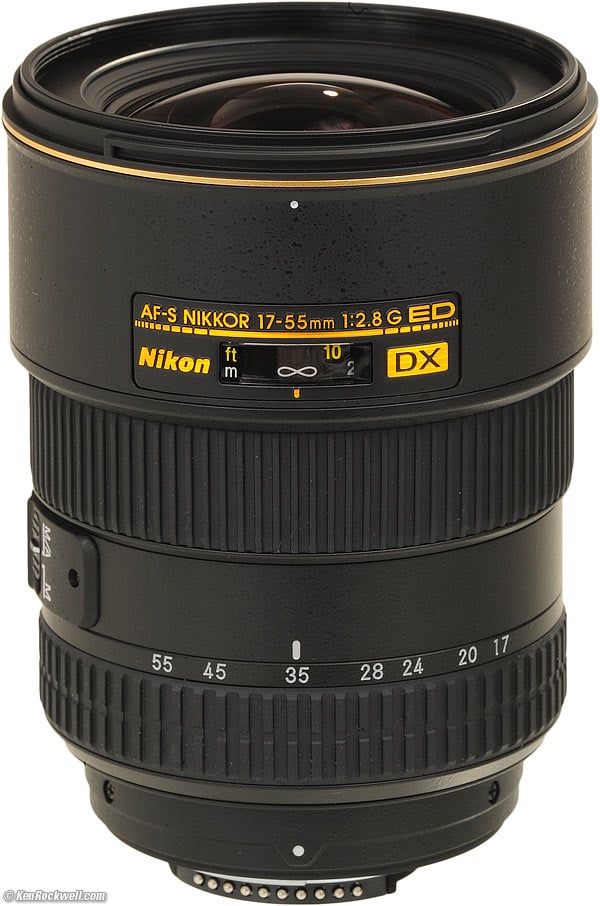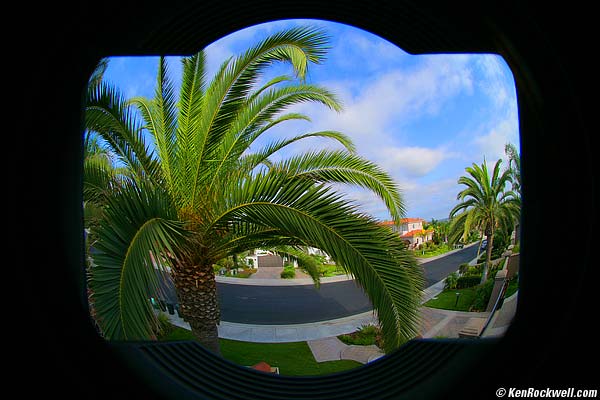Home Donate New Search Gallery Reviews How-To Books Links Workshops About Contact
Nikon
DX Lenses
© 2007 KenRockwell.com
Nikon 17-55mm f/2.8 DX. This free website's biggest source of support is when you use these links to Adorama, Amazon, B&H and eBay when you get anything, regardless of the country in which you live. Thanks! Ken.
August 2011, September 2007 Nikon Reviews Nikon Lenses Other Reviews
see also Crop Factor
Basics
|
I use Adorama, Amazon, Ritz, B&H, Calumet, J&R and ScanCafe. I can't vouch for ads below.
|
Nikon's DX lenses are lenses which only cover the smaller sensor of DX digital cameras. DX lenses have reduced capacity compared to regular lenses.
Used on a film or full-frame sensor, at some or all settings they will black-out in the corners. FX cameras have the option to use only a smaller section in the center of their larger sensors, so DX lenses will work properly on FX cameras, too.
There's no advantage to DX over other lenses due to the DX name itself. All Nikon digital SLRs have been designed from the ground up to use the same Nikkor lenses that have been around for years. Discount lens makers talk about special "digital" lenses just to get you to want to buy them instead. Ignore this.
The reason you care about DX lenses is that these extra short focal lengths are available only in DX, which is the only way to get wide lenses on DX digital cameras.
All Nikon lenses work great optically on the digital cameras, although AF and metering compatibility will vary case-by-case.
Background and Discussion
In the beginning, Nikon made 35mm film cameras. They shot film with an image size of 24 x 36mm.
In 1999 Nikon brought forth DX digital cameras, which used digital image sensors which were 1.5x smaller than 35mm film.
Until 2003, Nikon's widest zoom was the 17-35mm f/2.8, an $1,800 two-pound lens. Due to the crop factor, even a 17mm lens was not very wide on a DX camera. On DX cameras, it gave an angle of view similar to what a dull 26-50mm lens would on a 35mm film camera. This was boring, heavy and expensive.
The only way to get a truly wide view on a DX camera was to use the $2,000, two-pound 14mm f/2.8 AF to get an angle of view similar to what a 21mm lens sees on a 35mm camera. Life was a pain, and there were no practical full-frame fisheyes, unless you spent a few grand on the 8mm f/2.8 AI-s, which didn't cover the entire DX frame anyway.
In February 2003, Nikon introduced their first truly wide lens designed to cover the smaller format. It was the 12-24mm DX, which gave angles of view on a DX camera similar to what a 20-35mm lens does on a 35mm film camera. The 12-24mm was hard to buy for a year or two and remains expensive to this day, but it is lightweight and a great performer. There were no discount lens alternatives for another couple of years. (See also my digital ultrawide comparison.)
In July 2003 Nikon introduced the 10.5mm DX fisheye, which for the first time gave Nikon DX digital cameras the equivalent of the 16mm full-frame fisheye. Life was good!
Midrange film zooms got no wider than 24mm, which only gave a normal angle of view on DX cameras. Nikon also introduced various DX midrange zooms starting at 17mm or 18mm, which due to the crop factor, were zooms which started out with a field of view similar to what a 28mm lens sees on a 35mm film or FX camera.
Lens Compatibility
DX lenses will mount on any Nikon. They work ideally on DX digital cameras.
Used on a film camera, at some or all settings the corners will go black. Since all DX lenses are also G lenses without aperture rings, DX lenses won't work on manual focus cameras.
FX cameras can crop their sensors to use DX lenses, although that wastes much of the capability of the FX cameras, but it doesn't waste the DX lenses.
Here is what happens if you shoot the 10.5mm DX fisheye on film or an FX camera accidentally in full-frame mode:
10.5mm DX fisheye shot on a full-frame camera.
See how it only covers the smaller DX part of the sensor? Of course if you set up a D3 properly it will only use the center portion and look fine. This weird shape is how the 10.5mm's integral hood appears as seen through the fisheye.
Help me help you top
I support my growing family through this website, as crazy as it might seem.
The biggest help is when you use any of these links to Adorama, Amazon, eBay, B&H, when you get anything, regardless of the country in which you live. It costs you nothing, and is this site's, and thus my family's, biggest source of support. These places have the best prices and service, which is why I've used them since before this website existed. I recommend them all personally.
If you find this page as helpful as a book you might have had to buy or a workshop you may have had to take, feel free to help me continue helping everyone.
If you've gotten your gear through one of my links or helped otherwise, you're family. It's great people like you who allow me to keep adding to this site full-time. Thanks!
If you haven't helped yet, please do, and consider helping me with a gift of $5.00.
As this page is copyrighted and formally registered, it is unlawful to make copies, especially in the form of printouts for personal use. If you wish to make a printout for personal use, you are granted one-time permission only if you PayPal me $5.00 per printout or part thereof. Thank you!
Thanks for reading!
Mr. & Mrs. Ken Rockwell, Ryan and Katie.
Home Donate New Search Gallery Reviews How-To Books Links Workshops About Contact





